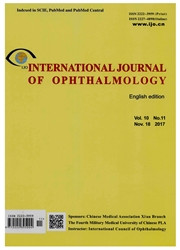

 中文摘要:
中文摘要:
AIM: To investigate the distribution of nestin-positive cells in pterygium, as well as the relationship between nestin -positive cells and proliferative cells in the pathogenesis of pterygium. ·METHODS: Nine pterygium specimens and 5 normal conjunctiva specimens were investigated. All explanted specimens were immediately immersed in 5-Ethynyl-2’- deoxyuridine, and were subjected to hematoxylin and eosin staining, as well as immunostaining to detect nestin. ·RESULTS: Small sub-populations of nestin-expressing cells in both normal and pterygial conjunctiva epithelium were found. These were located at the superficial layer of the epithelium, and were significantly increased (P =0.007) and spread out in the pterygial conjunctiva epithelium, even though these cells were mitotically quiescent.·CONCLUSION: In pterygium, more nestin-positive cells were present at the superficial layer of the epithelium. With growing scientific evidence that nestin plays an important role in defining various specialized cell types, such as stem cells, cancer cells and angiogenic cells, further investigations on the roles of nestin -expressing cells in pterygium may help to uncover the mechanisms of initiation, development and the prognosis of this disease.
 英文摘要:
英文摘要:
AIM: To investigate the distribution of nestin-positive cells in pterygium, as well as the relationship between nestin-positive cells and proliferative cells in the pathogenesis of pterygium. METHODS: Nine pterygium specimens and 5 normal conjunctiva specimens were investigated. All explanted specimens were immediately immersed in 5-Ethynyl-2'-deoxyuridine, and were subjected to hematoxylin and eosin staining, as well as immunostaining to detect nestin. RESULTS: Small sub-populations of nestin-expressing cells in both normal and pterygial conjunctiva epithelium were found. These were located at the superficial layer of the epithelium, and were significantly increased (P=0.007) and spread out in the pterygial conjunctiva epithelium, even though these cells were mitotically quiescent. CONCLUSION: In pterygium, more nestin-positive cells were present at the superficial layer of the epithelium. With growing scientific evidence that nestin plays an important role in defining various specialized cell types, such as stem cells, cancer cells and angiogenic cells, further investigations on the roles of nestin-expressing cells in pterygium may help to uncover the mechanisms of initiation, development and the prognosis of this disease.
 同期刊论文项目
同期刊论文项目
 同项目期刊论文
同项目期刊论文
 期刊信息
期刊信息
